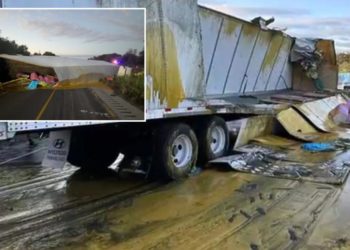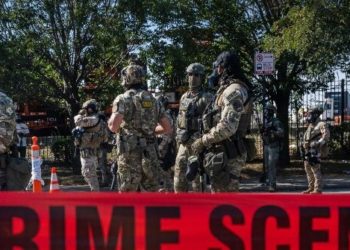KYIV — Oleksiy Pryma is a regional coordinator with the Proliska humanitarian mission responsible for evacuating and resettling Ukrainians from the front line — he’s a refugee himself.
Pryma fled his hometown of Severodonetsk in the eastern Luhansk region in February 2022 with his family. Five months later, Severodonetsk was destroyed and then occupied by the Russian army.
Pryma moved to Dnipro, a city in central Ukraine that has turned into a major hub for the Ukrainian army and for hundreds of thousands of refugees evacuating from the front, and started helping others to resettle around Ukraine.
Volunteers like Pryma are needed because Ukraine’s cash-strapped government is finding it very difficult to deal with millions of refugees — and the hundreds more evacuated from combat areas every day. Exiles face bureaucratic hurdles in getting compensation for destroyed homes or for property abandoned in Russian-occupied areas. Those who want to stay and rebuild also face enormous difficulties.
The problems are so large that some people even choose to return to areas under Russian occupation.
More than 4.5 million Ukrainians have registered as refugees inside the country, but the government insists it’s working hard to find new homes for them.
Even more have fled the country and registered as refugees in Western countries; many have no homes to return to.
In more than three years of war, Russian shelling has caused over $60 billion in damage to residential housing, the Kyiv School of Economics estimated earlier this year. And the destruction is continuing; almost every day, local authorities report that dozens of new buildings have been damaged or destroyed.
Getting help
The government does have a system in place for paying compensation to people with lost or damaged homes, but it’s not meeting the demand and the process is snarled in red tape.
The first step is to file an aid request under the eRecovery program — the government’s main vehicle to compensate homeowners. A special commission then arrives to assess the damage and provide people with protective tape to cover smashed windows. Volunteers help clean up any rubble, while residents start the exhausting process of getting money from local and central governments.
“We were told that the authorities will restore the façade only after New Year’s … and we have to repair [the] inside on our own. No money,” said Svitlana Fedorivna, a 73-year-old concierge from a residential building in Kyiv hit by a Russian drone on June 17.
In 2025, Ukraine allocated 15 billion hryvnia (€310 million) to support internally displaced refugees, Ukraine’s development ministry told POLITICO.
This has already enabled more than 7,300 families to purchase housing in safer regions. By the end of the year, another 3,000 families will get financing.
In total, more than 135,000 families have received state compensation under eRecovery — ranging from money for repairs to new housing.
The ongoing problem of housing evacuees was highlighted in August, when Proliska volunteers in the eastern city of Pavlograd complained they had to set up tents as there was no place to host the 400 new evacuees arriving every day, thanks to increased Russian attacks on Ukraine’s front-line communities.
“Last month, there was, let’s say, a peak in evacuation, when there was a really large flow of people and a bottleneck, but we drew the government’s attention directly. After our prime minister visited the transit center, the issue of resettlement, especially the resettlement of people with limited mobility, was resolved very quickly,” Pryma said.
After the August problems, the Ukrainian government became more actively involved in evacuation and resettlement, and is now trying to move more than 17,000 people from the war zone, Pryma said.
Authorities also announced a 1 billion hryvnia subsidy for local communities for the construction of temporary shelters, as well as simplified procedures for the transfer of state and municipal institutions to resettle refugees.
“Mostly families with children, and the elderly, are sheltered in different state dorms for free. Yes, it’s not your own flat, but still way better than living under relentless bombardment,” Pryma said, adding that some of the dorms have been freshly repaired.
There are a total of 1,095 temporary accommodation facilities in Ukraine, providing more than 77,000 beds for displaced people, of which about 6,200 beds remain vacant, the development ministry said.
In addition to the temporary housing, local governments are allocating hundreds of millions of hryvnia from local budgets for repair work and other compensation, as well as issuing low interest loans for new flats.
But the scale of the challenge is massive. Just in Kyiv — Ukraine’s wealthiest city — more than 2,345 residential buildings have been damaged since 2022, but the local government plans to rebuild only 52 of them, Kyiv city council said.
Living under Russian control
Ukrainians trapped in Russian-occupied regions face even greater difficulties. It was only last month that they won the right to file for compensation from Ukraine due to Kyiv’s inability to investigate damaged properties. The new program will not demand photo evidence of destroyed housing.
If they can’t get compensation, some Ukrainians are forced to return to Russian-occupied zones. Some 30 percent of residents of Mariupol — conquered by the Russians in a bloody siege that left thousands dead in the early months of the war — had to return, the Ukrainian mayor of Mariupol, Vadym Boychenko, said last year.
Lack of housing in regions controlled by Kyiv was the top reason for returning to Russian occupation, Boychenko said.
People are also going back because that’s the only way they can sell their properties, said Maksym Borodin, a lawmaker on the Mariupol city council in exile.
“Only someone with a Russian passport is allowed to sell a property. So, a Ukrainian must return to Mariupol, get a Russian passport … Only then is there a chance to sell,” Borodin added. The few houses that the Kremlin has constructed in Mariupol since 2022 have been sold to Russians.
People are realistic about the chances of the Ukrainian military’s retaking places like Mariupol.
“Unless Russia suddenly falls somehow, there’s no chance our city is going to be liberated anytime soon. Russians are now giving away people’s homes to loyalists in Mariupol. They are constantly listing the so-called ‘ownerless housing’ of those who fled,” Borodin said.
The government is even building a new housing block for Mariupol refugees in Bila Tserkva, a town in the Kyiv region.
Those kinds of brutal calculations are being forced on millions of people, including Pryma.
“It’s like you’re a tree that’s been suddenly uprooted … In an instant, you’ve lost everything you lived for and worked for. And the occupiers just took away everything, took away your house and gave it to some people unknown to you,” Pryma said.
Like many other internal refugees, he now lives in a rented apartment in Dnipro and has not even filed for compensation or a low interest housing loan.
“I still don’t know where I will end up … war is already in the Dnipro region, coming closer and closer. So, I can’t buy a flat. It’s not the time, as shelling destroys housing every day in Dnipro, and there’s a chance I will need to flee again in the future,” Pryma said.
The post Ukraine struggles to find homes for millions of refugees appeared first on Politico.




